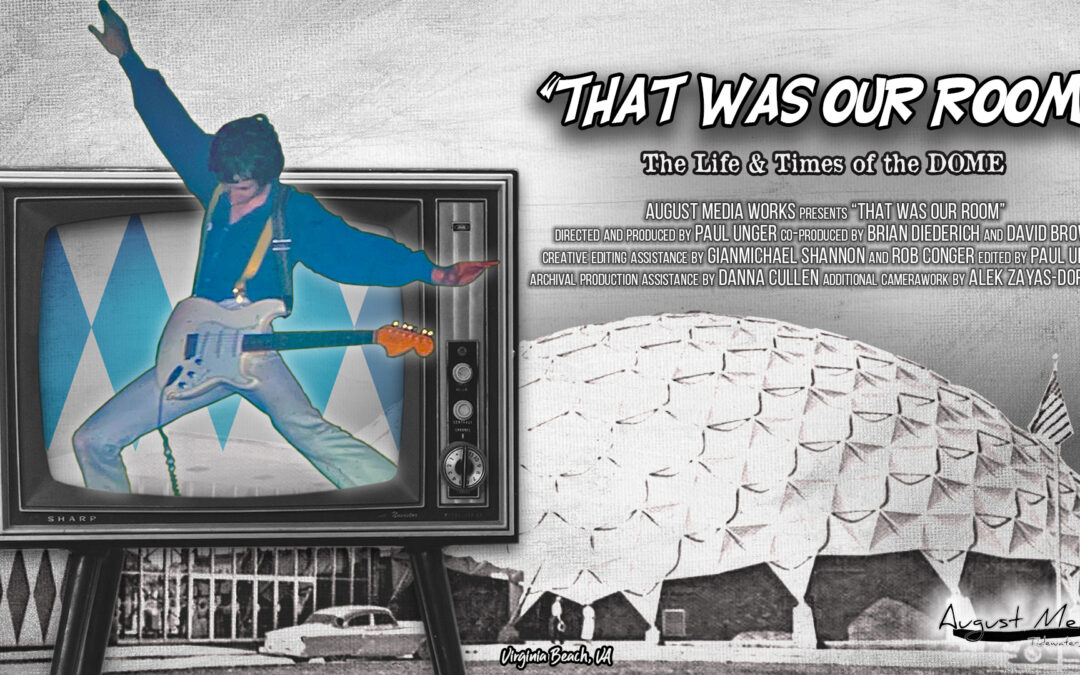By Jeff Maisey
With “That Was Our Room: The Life & Times of the Dome,” Norfolk-based documentarian Paul Unger hones-in his skills as a storyteller.
Unger, whose credits include “Hardcore Norfolk: The Movie,” is keen to set the stage with archival television footage and imagery brilliantly woven together. He digs deep in providing historical insights into the development of Virginia Beach as a resort and growing suburban landscape in the post World War II America, a boom time with a Baby Boomer generation seeking to leave urban areas for the good life of the suburbs, and families taking vacations en mass.
The space-age, futuristic look Dome was built in 1957 and was used for a variety of purposes including a concert venue. All the up-and-coming entertainers of the day performed in concert including The Rolling Stones, Jimi Hendrix Experience, Ray Charles, The Who, Black Sabbath, Patsy Cline, Frank Zappa, and countless others.
Throughout the documentary, Unger shows the viewer rare photographs of many of the performers and nicely integrates new video interview footage of local musicians, city historians, promoters like Gene Loving, concert-goers, former stagehands, record store owners, and others to tell the story.
The film will be shown free of charge on the following dates: June 12 at The Bunker Brewpub (7:30 PM), The Shack on 8th on June 20 (7:30 PM), and The Vanguard on June 29 (8 PM). All are free admission.
Here’s a brief Q&A we did with filmmaker Paul Unger for additional insights.
VEER: When/how did idea come to you to produce the documentary on The Dome?
Unger: About 10 years ago Barry Friedman, owner of Birdland Records, told me that Jimi Hendrix played in Virginia Beach — twice. Immediately I asked him “Where was this?” When he told me “The Dome,” I had this ongoing curiosity about the Dome and its history. My fascination with the place just grew and grew from there. I was so interested in the old Dome parking lot where it once stood before it was demolished almost became ‘sacred’ ground to me.
VEER: How long did it take to complete?
Unger: Originally, this whole documentary started simply as a 10 minute video piece about the Hendrix performances at the Dome and it would accompany an article I was going to write for the Hardcore Norfolk website. Well, that was in 2019. I just kept editing more and doing more research as time went about this so-called civic-center, it just kept on extending the time period to the point it became clear: The Dome, this geodesic structure, became the main character; the before, during and after of its existence, the story had to be told.
In August 2022, my mother passed away from cancer. After a few weeks of me grieving about her death, this documentary about the Dome sort of became my way of dealing with the whole loss, or perhaps distracting me from feeling depressed or whatever about her being gone, keeping myself occupied and productive with something, enabling me to move on more. Also, I knew she would want me to finish it, so I kept working at it a great deal more.
I recall calling my friend (and co-producer of this film) Brian Diederich, about two months ago last April, informing him that a full complete final-cut of the documentary was ready. A little polishing here and there but overall… the project was done. It was like a breath of fresh air when that happened, realizing this film had started four years ago and finally was completed.
VEER: What did you learn about the process from “Hardcore Norfolk: The Movie” that helped you with the new one?
Unger: The “Hardcore Norfolk” movie taught me a great deal about myself as being not just an editor, but also being a good storyteller of actual historical events, and being as accurate as possible. I also learned about the important relationships and teamwork that come along with making a film. Co-directors Andrea Rizzo and Debra Persons were great to work with, not to mention all the people that cared to contribute and help us with that film; great times. I used to always tell Deb and Andrea while we were making that movie, “Think of what we’re doing as creating something that captures a moment in time, that will always be there, even after we’re long gone.” I think that line might have encouraged them (laughs), not sure, but we finished it eventually, so I guess it worked.
I think also the “Hardcore Norfolk” movie helped me realize that sometimes certain details in a documentary film are not pleasant. The truth is sad sometimes, of course, but if something sad or controversial has a direct effect on what your documentary is about in some way, what you’re trying to reach across to your audience, it must be included. Yet, all scenes must be presented and edited in a certain way that makes sense to the viewers. Take for instance the death of someone, or the end of something special, as change is always inevitable with anything in life. “Yes” some things are hard to talk about, much less watch in a film, but those details are significant to tell the accurate history or story your covering about the main subject in your film. You’re making a documentary, not a sales video to appease certain people. Just be true to your film, yourself and your audience watching it and the whole thing will play out how it was meant to be.




